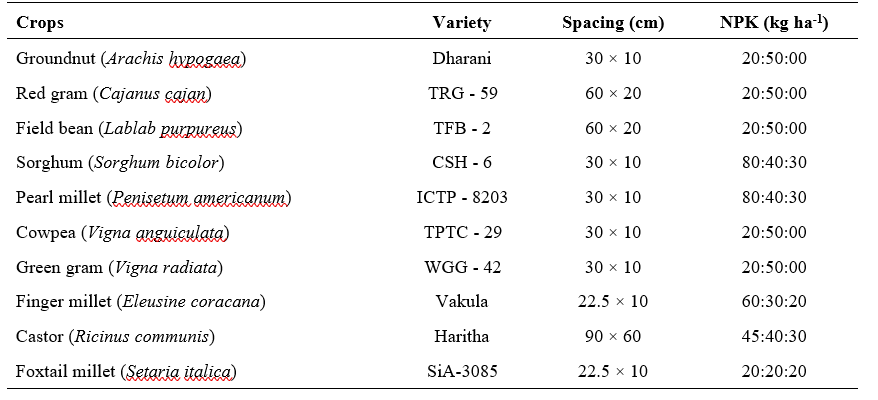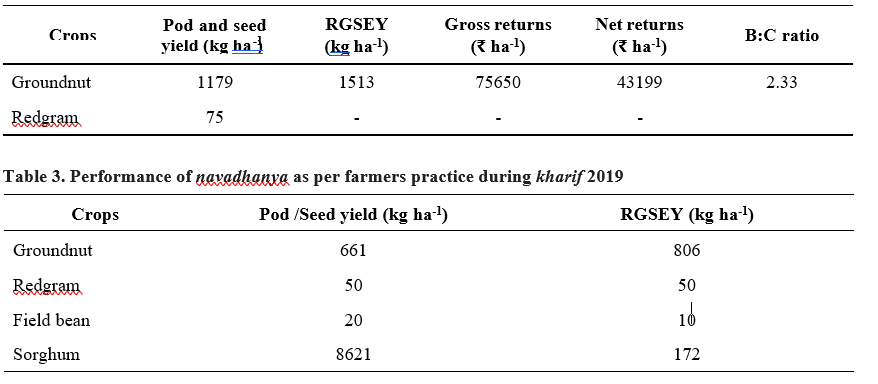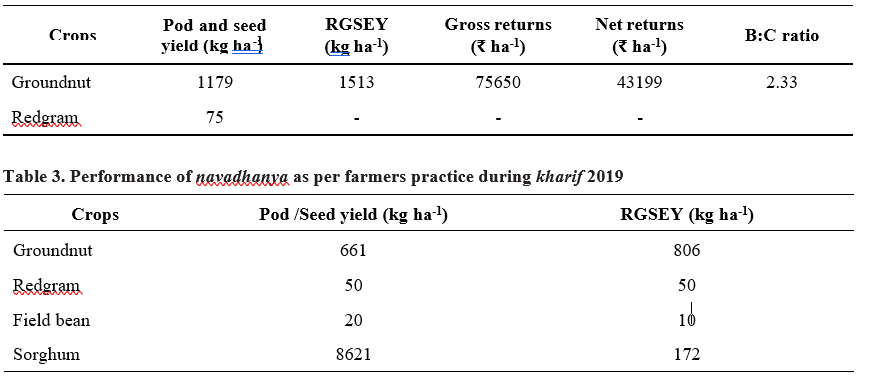Evaluation of Navadhanya Crops Under Strip Cropping in Farmers’ Field
0 Views
G. KRISHNA REDDY*, S. TIRUMALA REDDY, N. SUNITHA AND B. RAVINDRANATHA REDDY
Department of Agronomy, S.V. Agricultural College, ANGRAU, Tirupati-517502.
ABSTRACT
A field experiment entitled “Evaluation of navadhanya crops under strip cropping in farmer’s field” was conducted on farmer field at Sanyasipalle village in Chittor district of Andhra Pradesh during kharif 2019. Field experiment was conducted with three cropping systems as treatments, viz., T1– Groundnut + red gram (7:1) intercropping system, T2– Navdhanya as per farmers practice and T3– Navdhanya crops sown under strip cropping. Results revealed that groundnut + red gram (7:1) intercropping recorded maximum RGSEY (1102 kg ha-1), maximum gross returns (` 75650 ha-1), maximum net returns (` 43199 ha-1) and benefit-cost ratio (2.33) compared with navadhanya as per farmers practice and under strip cropping.
KEYWORDS: Navadhanya crops, intercropping, strip cropping, net returns and gross returns.
INTRODUCTION
Groundnut is an important commercial oilseed crop grown by Chittoor District farmers during kharif on alfisols under rainfed conditions. Unusual monsoon behavior is one of the crucial elements for crop yield in rainfed environments. Due to a delayed monsoon and protracted intermittent dry spells, the practice of growing groundnuts exclusively in the rainy season is occasionally found to be fairly unsafe. A feasible approach to deal with the issue is to stabilize the output of dry-land crops through the widely used technique of intercropping suitable crops. Intercropping has long been acknowledged as a form of biological assurance for vulnerabilities and abnormal rainfall behavior in dryland environments. It increases the cropping intensity, productivity, profitability, optimum utilization of soil, water, nutrients and sunlight (Kumar and Singh, 2006).
In the past, mixed and poly-cropping systems, known regionally by a diverse range of names, were prevalent over the Indian subcontinent (IAASTD, 2009; La Via Campesina, 2010; Deb, 2021). Rainfed farmers of Rayalseema region, which includes the districts of Anantapuram, Chittor, Kadapa, and Kurnool in the southern Indian state of Andhra Pradesh, has one such ancient cropping technique called Navadhanya. Navadhanya is a mixed farming technique evolved by farmers in the dryland region to successfully tackle and use the irregular rainfall they receive throughout the year. The cropping system is a combination of diverse millets, pulses, and oilseeds grown concurrently, which
keeps land cover 9-10 months of the year and provides different food and fodder crops to meet the food and nutrition needs of households and cattles, as well as adequate organic waste for crop nutrition, making it a wonderful sustainable dryland cropping system.
However, present agricultural systems are rapidly shifting toward monocrops (IOPEPC, 2017). It’s probable that the move from a mixed or poly-cropping system to a mono-cropping system had a range of repercussions on these small-marginal rainfed farmers (Naidu, et al 2019). According to research, farmers who grow peanuts as an irrigated monoculture are particularly vulnerable to suffering losses because of the relatively low returns, high risk of crop failure due to erratic rainfall, and unstable market prices (Kumar and Subramanyachary, 2015; Naidu, et al 2019).
Groundnut + red gram in 7:1 or 11:1 intercropping system is the normal practice followed by farmers in alfisols under rainfed conditions. Navadhanya crops sown under mixed cropping system have certain field problems. Hence, to avoid the operational problems it is pertinent to evaluate different navadhanya crops under strip cropping deserves priority. In this view, a field experiment is planned in farmer’s field to study the performance of different millets, pulses and oilseeds and identify compatible crops under navadhanya as per farmer practice and strip cropping of navadhanya crops.
MATERIAL AND METHODS
A field experiment entitled “Evaluation of navadhanya crops under strip cropping in farmer’s field” was conducted on farmer field at Sanyasipalle village in Chittoor district of Andhra Pradesh during kharif 2019. Field experiment with three cropping systems were used as treatments, viz., T1– Groundnut
+ red gram (7:1) intercropping system, T2– Navdhanya as per farmers practice (mixed cropping of red gram, sorghum, field bean and groundnut) and T3– Navdhanya crops (green gram, cowpea, sorghum, pearl millet, finger millet, castor, field bean, red gram and foxtail millet) sown under strip cropping with one row of red gram after every strip of navadhanya crop. The experimental farmer’s field soil was sandy loam in texture, neutral in reaction (pH – 6.6), low in organic carbon (0.38%), low in available nitrogen (216 kg ha-1), medium in available phosphorus (29.6 kg ha-1) and medium in potassium (278 kg ha-1). The crop varieties used for the study, row-to- row spacing, plant-to-plant spacing and recommended dosage of fertilizers were presented in Table 1. The plots of 32 m × 3.7 m size were used for each treatment. All of the management techniques for different crops were implemented as per the zonal reports of southern zone of Andhra Pradesh. All three cropping systems analyzed on the basis of system equivalent yield, returns and benefit- cost ratio.
The following formulas were used for calculating equivalent yield of crops and cropping systems
Redgram Seed equivalent Yield (RGSEY) =

Equivalent yield of system =
Yield of redgram + Redgram seed equivalent yield
RESULTS AND DISCUSSION
Yield
Maximum red gram seed equivalent yield (1102 kg ha-1) was recorded when groundnut intercropped with red gram in 7:1 (T1) (Table 2), which was 45.7 per cent and
251.8 per cent higher over navadhanya cropping system as per farmers practice and navadhanya crops sown under strip cropping, respectively (Table 3 and 4). Groundnut with red gram intercropping resulted in highest yield because of maximum and efficient utilization of growth resources by both crops coupled with better agronomic management. The findings corroborate those of Chandrika et al. (2001), who found that groundnut + red gram (7:1) intercropping produced higher net returns and total yield advantage than sole groundnut crop in rainfed alfisols. Similar outcomes were noted by Chaudhari et al. (2017) and Dutta & Bandyopadhyay (2006). Among
Table 1. Details of cultivation of navadhanya crops

Table 2. Performance of groundnut + red gram (7:1) (control – rainfed) during kharif 2019

Table 4. Performance of navadhanya crops under strip cropping during kharif 2019

strip cropping of red gram with navadhanya crops (T3) red gram + foxtail millet resulted in maximum RGSEY followed by red gram + castor strip intercropping system. Lowest RGSEY was recorded with red gram + finger millet strip row intercropping and red gram + red gram strip intercropping system (Table 4).
Economics
Among all three cropping systems groundnut intercropping with red gram (7:1) recorded highest gross returns (75650 ₹ ha-1) , net returns (43199 ₹ ha- 1) and benefit-cost ratio (2.33). Lowest gross returns and net returns was recorded with navadhanya crops sown under strip cropping, but lowest benefit-cost was recorded with navadhanya as per farmer practice (Table 5). Among strip cropping of navadhanya crops with red gram, highest gross return (7400 ₹ ha-1), net return (5963
₹ ha-1) and benefit-cost ratio (5.15) was recorded with red gram with foxtail millet and lowest with red gram +
Table 5. Yield, gross return, net return and benefit-cost ratio of navadhanya crops under different cropping systems during kharif 2019

finger millet strip row intercropping and red gram + red
gram strip intercropping system (Table 4).
Groundnut intercropping with red gram in 7:1 ratio is best cropping system for rainfed conditions in alfisols of Andhra Pradesh. Strip cropping of red gram along with foxtail millet and field bean may also resulted in high returns and benefits to farmers. However, expressed satisfaction with the performance of crops under navadhanya and desired for mechanization for reducing cost of production.
LITERATURE CITED
Chandrika, V., Sankara Reddy, K. and Soundararajan,
M.S. 2001. Economic evaluation of groundnut (Arachis hypogaea) based cropping systems in rainfed Alfisols. Indian Journal of Agronomy. 46(1): 45-49.
Chaudhari, D., Vekariya, P., Vora, V., Talpada, M and Sutaria, G. 2017. Enhancing productivity of groundnut based intercropping systems under rainfed conditions of Gujarat. Legume Research. 40(3): 520-525.
Deb, D. 2021. Productive efficiency of traditional multiple cropping systems compared to monocultures of seven crop species: a benchmark study. Experimental Results. 2(18): 1-10.
Dutta, D and Bandyopadhyay, P. 2006. Production potential of intercropping of groundnut (Arachis hypogaea L.) with pigeon pea (Cajanus cajan) and maize (Zea mays) under various row proportions in rainfed Alfisols of West Bengal. Indian Journal of Agronomy. 51(2):103-106.
IAASTD (International Assessment of Agricultural Knowledge, Science and Technology for Development). 2009. Agriculture at a cross- roads: global report. B.D. MacIntyre, H.R. Herren, J. Wakhungu, R.T. Watson, eds. Washington, DC, Island Press.
IOPEPC, 2017. Survey of groundnut crop, Kharif-2017. Indian Oilseeds and Produce Export Promotion Council, Mumbai.
Kumar, A and Singh, B.P. 2006. Effect of row ratio and phosphorus level on performance of chickpea (Cicer arietinum)-Indian mustard (Brassica juncea) intercropping. Indian Journal of Agronomy. 51(2): 100- 102.
Kumar, S.R and Subramanyachary, P. 2015. Major agricultural crops in Chittoor district. Indian Journal of Research. 4(5): 417-418.
La Via Campesina (LVC). 2010. Sustainable peasant and family farm agriculture can feed the world. Via Campesina Views no. 6. 15 pp.
Naidu, C.B., Kumar S and Rai, A.K. 2019. An economic analysis of production of groundnut (Arachis hypogea) in Ananthapur district of Andhra Pradesh. International Journal of Innovative Science and Research Technology. 4(5): 2456-2165.
- Bio-Formulations for Plant Growth-Promoting Streptomyces SP.
- Brand Preference of Farmers for Maize Seed
- Issues That Consumer Experience Towards Online Food Delivery (Ofd) Services in Tirupati City
- Influence of High Density Planting on Yield Parameters of Super Early and Mid Early Varieties of Redgram (Cajanus Cajan (L.) Millsp.)
- Influence of Iron, Zinc and Supplemental N P K on Yield and Yield Attributes of Dry Direct Sown Rice
- Effect of Soil and Foliar Application of Nutrients on the Performance of Bold Seeded Groundnut (Arachis Hypogaea L.)

